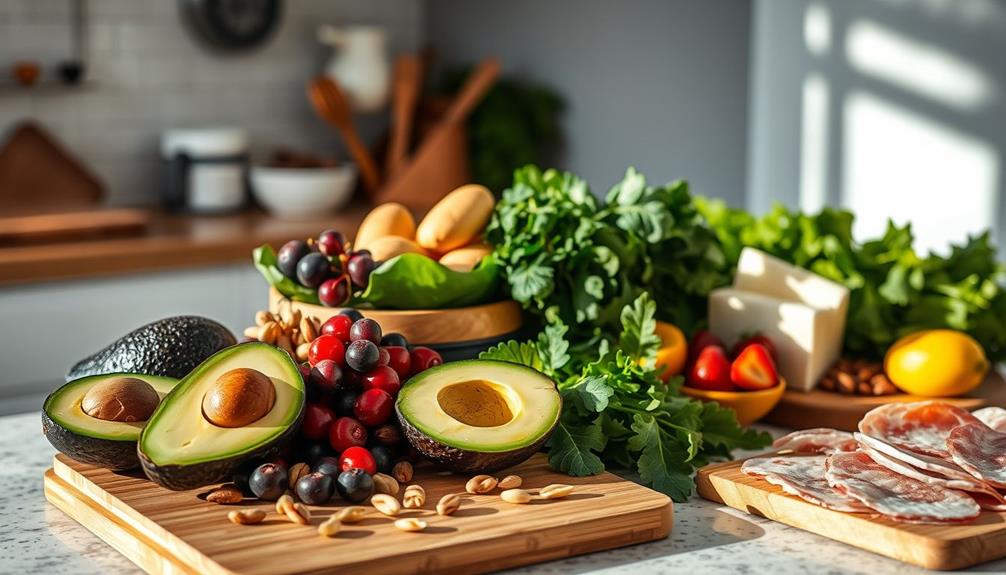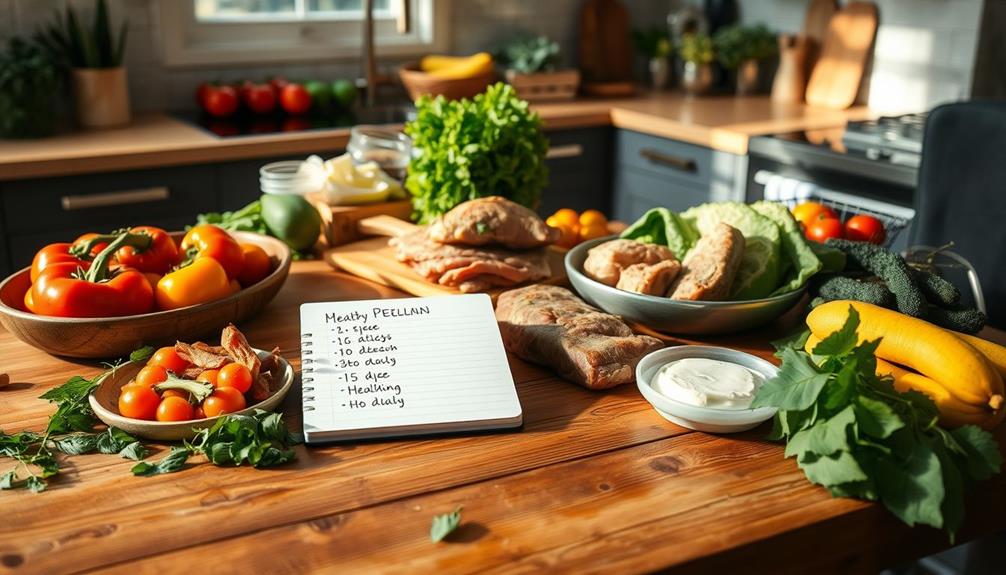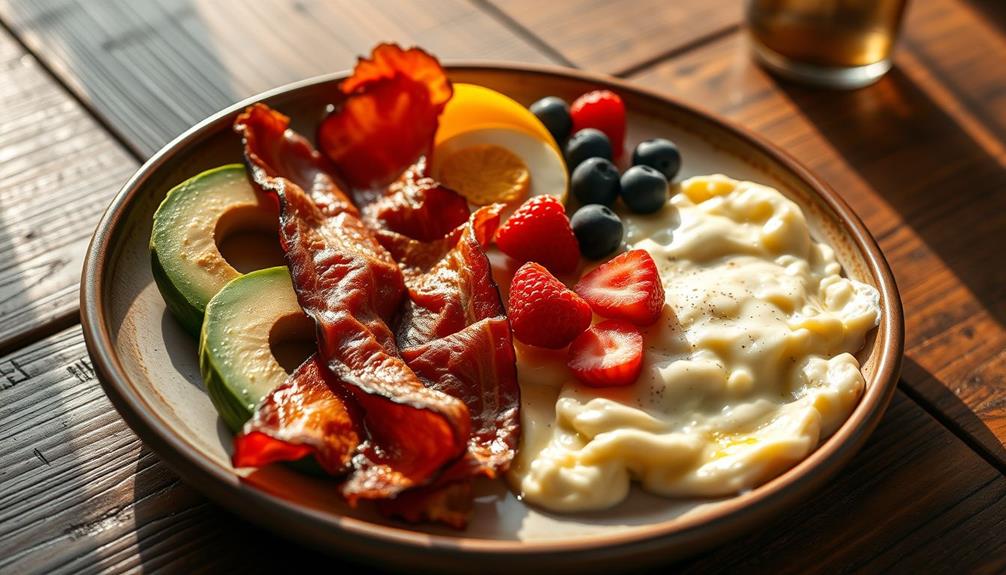To start a keto diet at home for free, focus on high-fat, low-carb foods like avocados, nuts, and fatty fish. Aim for about 70% fat, 25% protein, and just 5% carbs daily. Create a simple meal plan using non-starchy vegetables and protein sources, keeping your net carbs under 20 grams. Stay hydrated and manage potential keto flu symptoms by balancing electrolytes. Utilize online resources for recipes, meal plans, and community support. By connecting with others, you'll gain tips and motivation needed to succeed. There's plenty more to discover that can help you thrive on your keto journey. Getting started with keto diet is all about finding delicious and satisfying ways to eat while keeping your macronutrient ratios in check. Stock your kitchen with healthy fats like coconut oil and grass-fed butter, and experiment with new recipes to keep meals interesting. It’s important to listen to your body and make adjustments as needed, and remember that everyone’s experience with the keto diet is unique.Keep an open mind and be patient with yourself as you adapt to this new way of eating. With dedication and support, you can successfully transition to a keto lifestyle.
Key Takeaways
- Focus on high-fat, low-carb foods like avocados, nuts, and fatty fish while avoiding grains, sugar, and starchy vegetables.
- Create a simple meal plan using keto-friendly recipes to keep carbohydrate intake under 20 grams daily.
- Stay hydrated by drinking plenty of water and maintaining electrolyte balance to combat keto flu symptoms.
- Utilize online resources, forums, and social media for meal ideas, support, and motivation from keto communities.
- Plan meals ahead and monitor macronutrient ratios to ensure adherence to the keto diet.
Understanding the Keto Diet

The Keto Diet is a high-fat, low-carbohydrate eating plan designed to shift your body into a state called ketosis. In this metabolic state, your body burns fat for fuel instead of relying on carbohydrates.
To achieve ketosis, you typically need to limit your carb intake to less than 20 grams of net carbs per day. This drastic reduction in carbs forces your body to produce ketones in the liver, providing an alternative energy source.
Incorporating antioxidant-rich foods, such as celery juice, can complement your diet and promote overall health. The ketogenic diet usually consists of 70-75% healthy fats, 20-25% protein, and only 5-10% carbohydrates. This balance helps you feel satiated while promoting significant weight loss, especially in the initial months.
Many people find that they experience reduced hunger, making it easier to stick to the low carb diet.
Understanding which foods to eat is essential for success on the Keto diet. Focus on incorporating healthy fats like avocados, nuts, and olive oil, while avoiding sugar and starches.
With the right approach, you can effectively shift to a ketogenic lifestyle and enjoy the benefits of improved metabolic health and weight management.
Essential Foods for Keto

When starting on a keto diet, choosing the right foods is essential for success. Focus on incorporating high-fat, low-carb foods that should make up 60-80% of your daily caloric intake. Include avocados, nuts, seeds, fatty fish, and healthy oils in your keto food list. These foods provide the necessary fats to support ketosis and are important for effective strategies for weight loss.
Next, add non-starchy vegetables like leafy greens, zucchini, and cauliflower. These veggies are low in carbs and high in fiber, giving you essential nutrients without exceeding your carb limits.
For protein sources, opt for meat, poultry, eggs, and full-fat dairy, ensuring protein comprises about 15-20% of your daily caloric intake. This helps maintain muscle without converting excess protein to glucose.
To stay on track, avoid high-carb foods such as grains, sugar, starchy vegetables, and most fruits, as they can hinder your ability to achieve ketosis.
For in-between meals, utilize keto-friendly snacks like cheese, hard-boiled eggs, and macadamia nuts. They'll help manage hunger while keeping you within your carbohydrate limits, ensuring you enjoy your ketogenic meals without sacrificing satisfaction.
Creating a Simple Meal Plan

To successfully navigate your keto journey, crafting a simple meal plan is essential. Start by selecting a variety of high-fat, low-carb foods like avocados, nuts, eggs, meat, and non-starchy vegetables. These will form the foundation of your meals.
Understanding the mechanics of meal prep can enhance your cooking experience, making it easier to stick to your plan. Create a weekly meal plan that includes breakfast, lunch, dinner, and snacks, guaranteeing each day keeps your carbohydrate intake below 20 grams to stay within ketosis. You might also consider incorporating a cup of coffee into your routine, as different brewing methods can affect caffeine levels, adding an extra boost to your day.
Utilize online resources and free meal planning tools to discover keto-friendly recipes that match your tastes and macronutrient goals. Incorporate meal prep strategies by cooking larger portions and using leftovers, which simplifies your cooking process and reduces the temptation to stray from your diet.
Keep a shopping list focusing on keto staples, making grocery shopping efficient. This guarantees you have all the necessary ingredients to stick to your meal plan.
Managing Keto Flu Symptoms

Experiencing keto flu symptoms is common for many who start a ketogenic diet, and knowing how to manage them can make your change smoother.
During the adaptation phase, you might face fatigue, headache, irritability, and nausea as your body shifts to burning fats instead of carbohydrates. It's also important to take into account other wellness practices, such as incorporating natural remedies alongside conventional medications, which can support your overall health during this change.
One key to alleviating these symptoms is hydration. Aim for about 16 cups of water per day to help combat dehydration since your body excretes more water when you cut carbs.
Along with hydration, maintaining an electrolyte balance is essential. Foods rich in sodium, potassium, and magnesium—like bone broth, avocados, and leafy greens—can greatly reduce discomfort.
Another effective strategy is a gradual reduction in carbohydrate intake over a week rather than switching abruptly. This can ease your change and lessen the severity of keto flu symptoms.
Additionally, incorporating light physical activity, such as walking or stretching, can help boost your energy levels and improve your well-being during this challenging adaptation phase.
Finding Online Resources

Finding reliable online resources can make your shift to a keto diet much easier. Start by exploring reputable health websites like the Cleveland Clinic and Mayo Clinic, which offer expert insights and guidelines on starting a keto diet for free.
These sites can help you understand the fundamentals of a keto diet plan and provide tips to optimize your macronutrient intake. Additionally, understanding how to track your budget can be beneficial when planning your keto meals and shopping list, ensuring you stay within your financial limits.
Utilize platforms like Familydoctor.org, where you'll find practical advice for beginners. They can guide you through meal planning tools and calculators, helping you track your daily meals effectively.
You can also discover a wealth of keto recipes tailored to your taste preferences.
Don't underestimate the value of community engagement. Join online forums or support groups dedicated to the keto diet, where members share their experiences and meal ideas at no cost.
Following social media accounts and YouTube channels focused on keto can also be beneficial; they often provide free content that inspires you with new recipes and tips.
Connecting With Keto Communities

Connecting with others on a keto journey can markedly enhance your experience and success. By joining online forums and social media groups dedicated to the keto diet, you'll gain valuable support, motivation, and shared experiences from fellow dieters.
These communities are treasure troves of meal plans, recipes, and grocery lists tailored specifically for the keto lifestyle, helping you stay organized and informed. Engaging with these groups can also boost your curiosity, which is linked to higher levels of happiness and satisfaction in life, as you explore diverse perspectives and experiences from others the benefits of curiosity.
Participating in keto challenges hosted by these communities can boost your accountability while introducing you to new recipes and meal ideas. It's a great way to foster camaraderie and make lasting connections.
Look for local meetups or virtual events that allow you to engage with others on a similar path. You can exchange tips and strategies that have worked for you, while also gathering encouragement from those who understand your journey.
Don't miss out on expert-led webinars or Q&A sessions within these communities. They provide insights into best practices and address common concerns associated with starting a keto diet.
Engaging with others not only motivates you but can also make your adaptation to this lifestyle much smoother and more enjoyable.
Frequently Asked Questions
How Do I Start My Keto Diet for the First Time?
To start your keto diet, focus on understanding macronutrient ratios. Create a meal plan with high-fat foods, track your intake, and prepare for initial adjustments. Experiment with easy recipes to simplify your cooking process.
What Is a Keto Diet Plan for Beginners?
A keto diet plan for beginners gently guides you toward a low-carb lifestyle. You'll embrace healthy fats, moderate protein, and avoid sugary treats. Meal planning's key, helping you stay organized and track your progress effectively.
What Are the 9 Rules of Keto?
The nine rules of keto include limiting carbs, prioritizing healthy fats, moderating protein intake, staying hydrated, tracking food intake, ensuring electrolyte balance, eating whole foods, avoiding processed foods, and being patient with your progress.
What Should I Buy to Start a Keto Diet?
Picture a plate filled with vibrant veggies contrasting against rich, creamy fats. You'll want to buy avocados, olive oil, fatty meats, low-carb veggies, and full-fat dairy while avoiding grains and sugary snacks for a successful keto journey.
Conclusion
Starting a keto diet at home doesn't have to break the bank—it's as easy as pie! By understanding the basics, stocking up on essential foods, and planning your meals, you'll be well on your way to success. Don't forget to manage those pesky keto flu symptoms and tap into the wealth of online resources and communities. Embrace the journey, and watch as your body transforms into a fat-burning machine! Immerse yourself and enjoy the ride!








